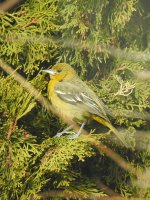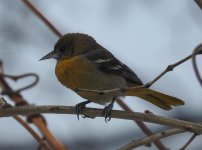StellaMaris
Member
I've been attending to (what I believe is) a female Baltimore Oriole in my Toronto (Canada) back yard since around November 15, 2020. I'm wondering if someone can confirm whether she is in fact a female Baltimore Oriole, and whether it's possible to discern whether she's a younger or older bird.
Baltimore Orioles were plentiful in my back yard this past summer, and I think I noticed this same female when I took closeup photos back then, as her upper beak (culmen?) appeared to be more curved than others', and her colouring was a little different from the other female Orioles'. A male Orchard Oriole also stopped by one early summer day; apart from the colour, the size difference was very obvious to me. By early autumn, I was certain the Orioles had left, although I vaguely recall noticing what looked like a female now and then, several weeks after the last of the males was gone.
I was surprised to spot her on one of my suet feeders on November 15. Since this feeder was monopolized by other birds, I scrambled to set up additional feeding areas for her. Things have evolved to the point she now has her own feeder and water platform up against my dining room window to keep her somewhat separate from the aggressive Mockingbird and other birds. To my surprise, the only things she eats are peanuts (which she grates into very fine bits with her beak) and live mealworms -- no interest in anything else, including the suet, sunflower seeds without shell, any kind of fruit or jelly. She can be seen at various angles in this video:
And here she is closer up, grating some peanuts. I think somehow her beak looks even larger/more curved in this one! 😅
Any help with confirming who she is, and any anecdotes of other Orioles wintering uncharacteristically north, would be much appreciated!
Baltimore Orioles were plentiful in my back yard this past summer, and I think I noticed this same female when I took closeup photos back then, as her upper beak (culmen?) appeared to be more curved than others', and her colouring was a little different from the other female Orioles'. A male Orchard Oriole also stopped by one early summer day; apart from the colour, the size difference was very obvious to me. By early autumn, I was certain the Orioles had left, although I vaguely recall noticing what looked like a female now and then, several weeks after the last of the males was gone.
I was surprised to spot her on one of my suet feeders on November 15. Since this feeder was monopolized by other birds, I scrambled to set up additional feeding areas for her. Things have evolved to the point she now has her own feeder and water platform up against my dining room window to keep her somewhat separate from the aggressive Mockingbird and other birds. To my surprise, the only things she eats are peanuts (which she grates into very fine bits with her beak) and live mealworms -- no interest in anything else, including the suet, sunflower seeds without shell, any kind of fruit or jelly. She can be seen at various angles in this video:
And here she is closer up, grating some peanuts. I think somehow her beak looks even larger/more curved in this one! 😅
Any help with confirming who she is, and any anecdotes of other Orioles wintering uncharacteristically north, would be much appreciated!
Last edited:






